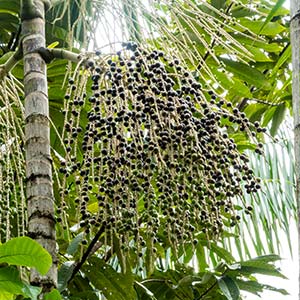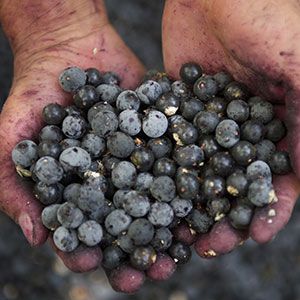Acai Berry: This Superfruit Offers Antioxidant Benefits
This superfood from the Brazilian rainforest is commonly added to smoothies for its antioxidant benefits, but when it comes to sharing it with pets, moderation is key. Here’s how to safely add it to their meals.

STORY AT-A-GLANCE
- Acai has gained popularity due to its high antioxidant profile; its antioxidant capacity is higher than that of other berries like blueberries and cranberries
- A 2016 study published in the Journal of Functional Foods found that acai extract may have neuroprotective effects. This benefit stems from acai’s various flavonoids, namely anthocyanins and proanthocyanidins
- Acai has a rich fatty acid content. The berry’s lipid composition consists of 11.1% polyunsaturated fatty acids, 60.2% monounsaturated fatty acids and 28.7% saturated fatty acids
- Acai contains theobromine — the same compound in chocolate that may be toxic to dogs. The key to feeding it safely to pets is to use moderation, by adding only a teaspoon or two to your pet’s food
Editor's Note: This article is a reprint. It was originally published March 9, 2023.
In a 2016 article, Animal Wellness Magazine listed acai (pronounced “ah-sigh-EE”) berry as one of the “top healing superfruits” that you can share with your pets,1 due to its impressive nutrients that can bring many health benefits. However, there are conflicting reports advising that acai should not be fed to pets as it contains a compound that may be toxic to them.2
So what’s the real deal with acai berries? Can you add it to your dogs’ and cats’ food or is it safer to keep it out of their diet? Keep reading to learn more.
What Is Acai Berry and Why Is It Considered a Superfood?
Also called assai, the acai berry (Euterpe oleracea) comes from a species belonging to the palm plant family, which is grown for both the fruits and edible hearts of palm. The berries, which are drupes that look like blueberries, are about 1.5 centimeters in diameter, with a large seed inside. When they ripen, they turn from green to a deep purple color.3
Just like other berries, acai has gained popularity due to its high antioxidant profile; it’s been recognized as one of the top foods with high oxygen radical absorption capacity (ORAC) values, which measures antioxidants’ ability to effectively neutralize free radicals.4 In fact, its antioxidant capacity was found to be higher than that of other berries like blueberries and cranberries.5 What’s more, it offers impressive amounts of essential fatty acids, amino acids and fiber.6
So if acai berries contain a good amount of antioxidants and other nutrients, why are there claims that they could be toxic to pets? It’s all because of a compound called theobromine.
Acai Is OK for Pets in Moderate Amounts
Many online sources have warned of acai’s theobromine content — this is the same compound in chocolate that is toxic to pets. Theobromine affects the cardiovascular, respiratory and central nervous system, and since your pet’s body cannot break down theobromine, consuming it in excessive amounts could prove to be fatal.
The amount of theobromine in acai berries is negligible (0.0014mg/g)7 compared to cacao (containing an average of 0.82mg/g),8 with one report stating the berries “cannot be considered a significant source of this metabolite.”9 The key is to make sure to give acai to pets in moderation, by using small amounts of pureed fruit as a treat or topper.
If given in very minimal amounts, acai can be a tasty, healthy addition to your pet’s nutritionally balanced, species-appropriate diet without causing any issues — they can safely reap the benefits without experiencing any negative effects. Other theobromine-containing foods like chocolate should be completely avoided, though.
Did You Know?

The name “acai” comes from a word from the Tupi language: “iwaça’I.” It translates to “the fruit that cries or expels water,” because when acai is extracted, the pulp slowly flows like tears.10
The word is also related to the interesting legend on how it came to be — hundreds of years ago, Iaçã, a maiden from an ancient Amazonian tribe, made an ultimate sacrifice so that her people wouldn’t starve. These berries were believed to have come from Tupã, the god of thunder, giving sustenance to their civilization.11
In the Amazon region, acai berries have been considered a staple food for many centuries by indigenous civilizations. Outside of Brazil, though, it is difficult to find fresh due to its short shelf life, owing to its delicate nature. Exported acai is usually sold dried, flash frozen or powdered as a dietary supplement.12
Acai Berries Are Loaded With Beneficial Fatty Acids
A standout characteristic of acai is its rich fatty acid content. The berry’s lipid composition consists of 11.1% polyunsaturated fatty acids, 60.2% monounsaturated fatty acids and 28.7% saturated fatty acids. Oleic acid, a substance also found in olive oil, makes up 53.9% of the monounsaturated fatty acids in acai berries.13,14
These healthy fats offer a number of benefits for pets; omega-3s, for example, are helpful for maintaining healthy skin and coat in pets, as well as helping manage their triglyceride, cholesterol and blood pressure levels. As for omega-6s, they help with optimal immune function, proper cell growth, and skin and coat health as well. These two fatty acids must be in balance with each other.15
As for oleic acid, also called omega-9, Animal Wellness Magazine notes that it may have an effect on skin and heart health.16 Although it’s called a “nonessential” fatty acid, it may actually play a role in optimizing cholesterol levels.17
While acai berries offer an assortment of beneficial plant-based fatty acids, they do not take the place of pets’ high requirements for the omega-3s docosahexaenoic acid (DHA) and eicosapentaenoic acid (EPA). It’s important to supply your pet’s diet with EPA and DHA from marine-based sources for good health.
Potent Antioxidants in Acai May Help Boost Brain Health
A 2016 study published in the Journal of Functional Foods found that acai extract may have neuroprotective effects.18 This benefit stems from acai’s various flavonoids, namely anthocyanins and proanthocyanidins.
Anthocyanins, which are mainly found in brightly colored vegetables and fruits, and give acai berries their deep purple color, are known to help support cognitive function and slow down age-related memory decline. Some anthocyanins can even cross the blood-brain barrier and may inhibit neuroinflammation and improve blood flow to the brain.19 According to another study:20
“Different mechanisms and pathways are involved in the protective effects [of anthocyanins], including free-radical scavenging pathway, cyclooxygenase pathway, mitogen-activated protein kinase pathway, and inflammatory cytokines signaling.”
In companion animals, studies found that feeding a diet rich in antioxidants helped senior beagles learn complex tasks more successfully than dogs that did not get antioxidants.21 The study authors concluded:22
“[P]roviding a broad spectrum of cellular antioxidants and mitochondrial co-factors within a specially-formulated food leads to significant benefits to cognition and maintenance of function at doses that were well within those used in human clinical trials.”
Anthocyanins may also help improve immune health and protect against obesity. According to a review published in the journal Biomolecules, these antioxidants help decrease the production of inflammatory cytokines in obese animal models, based on in vitro and in vivo studies. The authors concluded that anthocyanins may help “reduce the risks of the most common chronic noncommunicable diseases.”23
Acai Is Highly Perishable

The primary concern when it comes to harvesting and exporting acaí is that the berries ferment extremely fast. Only in local areas in Brazil, such as Belém, is acai consumed as a fresh fruit. As for the majority of the yield, they’re mostly processed into pulp directly after harvesting.24
How to Share Acai With Your Pets
“Acai can be bought in powder form, or as a puree or juice. Look for organic, spray-free brands to ensure you avoid exposure to chemicals and pesticides.”
Frozen puree is the closest you can get to fresh acai berries, so make sure to look for it in the freezer section of your grocery store. Give a small amount of acai at a time, adding a teaspoon per 25 pounds of body weight to your pet’s meals as a food topper. You can also mix the puree with other mashed or soft foods (like squash or plain yogurt), then spread it on their lick mat.
It can also be used as an ingredient in homemade training treats, keeping in mind that all healthy treats should make up less than 10% of your healthy pet’s daily caloric intake. For example, you can add some of the puree when making these frozen coconut oil and berry treats.
Where Does Acai Grow?

The acai plant is native to Brazil, where it grows predominantly in floodplains, swamps and the Amazon rainforest. It also grows in Trinidad and in many parts of northern South America.25

The Sustainability of Acai Cultivation
Due to acai’s increasing demand worldwide, there’s been a boom in the cultivation of this plant in Brazil, with exports growing by a whopping 14,380% over the past 10 years. However, the expanding acai plantations have affected the Amazonian ecosystem — there is a decline in lowland tree species, as well as in pollinating insects that are essential to acai production.
“In some areas you have practically a monoculture of acai, when normally there would be as many as 70 different species of trees and palms per hectare in these areas,” ecologist Ima Vieira said.26
As a result, there are initiatives to manage acai production in a sustainable manner. This includes training riverside farmers to do low-impact acai farming techniques. The Reference Center for the Management of Native Açai Palms, or Manejaí, is one example of a project that supports sustainable acai production. According to Manejai coordinator Teofro Lacerda:27
“With it, we were able to increase productivity and obtain better-quality fruit. People need to value this product more, because its management takes a lot of work. And companies that buy it also need to make a social commitment to our communities.”
Sources and References
- 1 Animal Wellness, September 30, 2016
- 2 Puplore, May 16, 2022
- 3 Britannica, Acai
- 4,6 Victoria Health, Facts And Myths About Acai Berry
- 5 Chem Cent J. 2011; 5: 5
- 7 Foods, 2013, 1
- 8 Malays J Nutr. 2000 Mar;6(1):55-63
- 9 MDPI, March 25, 2013
- 10 Science Direct, Açai or Brazilian Berry (Euterpe oleracea)
- 11 Vida Boa Acai, The Origin of Acai: The Typical Fruit of the Brazilian Amazon
- 12 Got Milk?, What Is an Acai Bowl?
- 13 Int. J. Cardiovasc. Sci. 32 (2), Mar-Apr 2019
- 14 J Agric Food Chem. 2006 Nov 1;54(22):8598-603
- 15 Only Natural Pet, January 5, 2021
- 16 Animal Wellness, October 4, 2019
- 17 HowIMetMyDog.com, Unc(oil)ing the Truth About Natural Oils for our Pets
- 18 Journal of Functional Foods, Volume 26, October 2016, Pages 385-393
- 19 Petfood Industry, March 1, 2020
- 20 Food Nutr Res. 2017; 61(1): 1361779
- 21,22 Biochim Biophys Acta. 2012 May; 1822(5): 685–689
- 23 Biomolecules 2022, 12(6), 852
- 24 Fresh Plaza, November 8, 2016
- 25 LifeHack, 15 Things You Need To Know About Acai Berry
- 26,27 Mongabay, November 3, 2021











